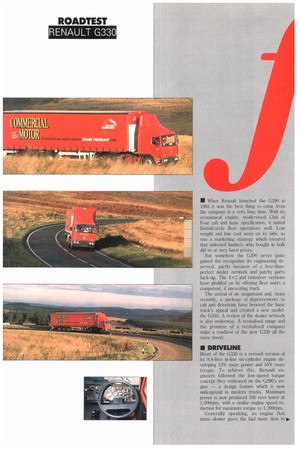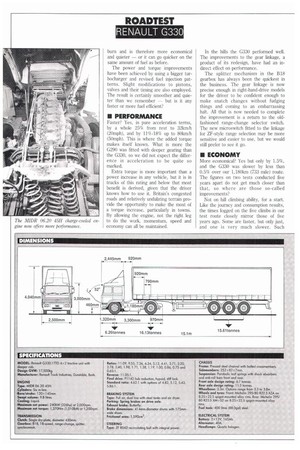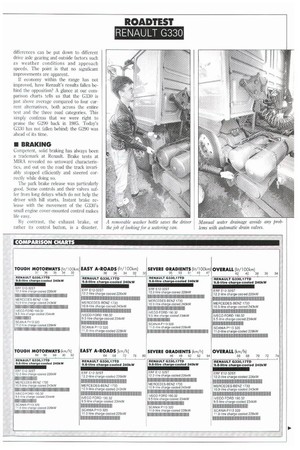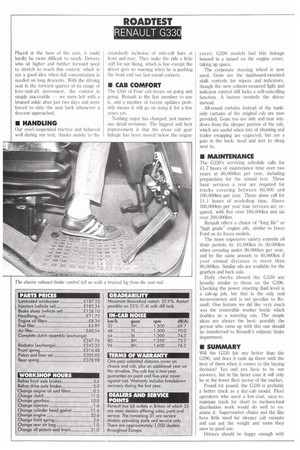• When Renault launched the G290 in 1985 it was
Page 34

Page 36

Page 37

Page 38

Page 39

If you've noticed an error in this article please click here to report it so we can fix it.
the best thing to come from the company in a very long time. With its economical engine, modernised Club of Four cab and basic specification, it suited British-style fleet operations well. Low weight and low cost were on its side, as was a marketing strategy which ensured that selected hauliers who bought in bulk did so at very keen prices.
But somehow the G290 never quite gained the recognition its engineering deserved, partly because of a less-thanperfect dealer network and patchy parts back-up. The 4x2 and twinsteer versions have plodded on by offering fleet users a competent, if unexciting truck.
The arrival of air suspension and, more recently, a package of improvements to cab and drivetrain have boosted the basic truck's appeal and created a new model: the G330. A review of the dealer network is also underway. A revitalised range and the promise of a revitalised company make a roadtest of the new G330 all the more timely.
• DRIVELINE
Heart of the G330 is a revised version of its 9.8-litre in-line six-cylinder engine developing 12% more power and 16% more torque. To achieve this, Renault engineers followed the low-speed torque concept they embraced on the G290's engine — a design feature which is now widespread in modern trucks. Maximum power is now produced 100 revs lower at 2,000rpm, with a similar engine speed reduction for maximum torque to 1,200rpm.
Generally speaking, an engine that turns slower gives the fuel more time to pl.
burn and is therefore more economical and quieter — or it can go quicker on the same amount of fuel as before.
The power and torque improvements have been achieved by using a bigger turbocharger and revised fuel injection patterns. Slight modifications to pistons, valves and their timing are also employed. The result is certainly smoother and quieter than we remember — but is it any faster or more fuel efficient?
• PERFORMANCE
Faster? Yes, in pure acceleration terms, by a whole 25% from rest to 32km/h (20mph), and by 11%-18% up to 80km/h (50mph). This is where the added torque makes itself known. What is more the G290 was fitted with deeper gearing than the G330, so we did not expect the difference in acceleration to be quite so marked.
Extra torque is more important than a power increase in any vehicle, but it is in trucks of this rating and below that most benefit is derived, given that the driver knows how to use it. Britain's congested roads and relatively undulating terrain provide the opportunity to make the most of a torque increase, particularly in towns. By allowing the engine, not the right leg to do the work, momentum, speed and economy can all be maintained. In the hills the G330 performed well. The improvements to the gear linkage, a product of its redesign, have had an indirect effect on performance.
The splitter mechanism in the B18 gearbox has always been the quickest in the business. The gear linkage is now precise enough in right-hand-drive models for the driver to be confident enough to make snatch changes without fudging things and coming to an embarrassing halt. All that is now needed to complete the improvement is a return to the oldfashioned range-change selector switch. The new microswitch fitted to the linkage for ZF-style range selection may be more sensitive and easier to use, but we would still prefer to see it go.
• ECONOMY
More economical? Yes but only by 1.5%, and the G330 was slower by less than 0.5% over our 1,180km (733 mile) route. The figures on two tests conducted five years apart do not get much closer than that, so where are those so-called improvements?
Not on hill climbing ability, for a start. Like the journey and consumption results, the times logged on the five climbs in our test route closely mirror those of five years ago. Some are faster, but only just, and one is very much slower. Such differences can be put down to different drive axle gearing and outside factors such as weather conditions and approach speeds. The point is that no significant improvements are apparent.
If economy within the range has not improved, have Renault's results fallen behind the opposition? A glance at our comparison charts tells us that the G330 is just above average compared to four current alternatives, both across the entire test and the three road categories. This simply confirms that we were right to praise the G290 back in 1985. Today's G330 has not fallen behind; the G290 was ahead of its time.
• BRAKING
Competent, solid braking has always been a trademark at Renault. Brake tests at MIRA revealed no untoward characteristics, and out on the road the truck invariably stopped efficiently and steered correctly while doing so.
The park brake release was particularly good. Some controls and their valves suffer from long delays which do not help the driver with hill starts. Instant brake release with the movement of the G330's small engine cover-mounted control makes life easy.
By contrast, the exhaust brake, or rather its control button, is a disaster.
Placed at the base of the seat, it could hardly be more difficult to reach. Drivers who sit higher and further forward need to stretch to reach this control, which is not a good idea when full concentration is needed on long descents. With the driving seat in the forward quarter of its range of fore-and-aft movement, the control is simply inaccesible we were left with a bruised ankle after just two days and were forced to slide the seat back whenever a descent approached.
• HANDLING
Our steel-suspended tractive unit behaved well during our test, thanks mainly to the (standard) inclusion of anti-roll bars at front and rear. They make the ride a little stiff for our liking, which is fine except the driver gets no warning when he is pushing the front end too fast round corners.
• CAB COMFORT
The Club of Four cab keeps on going and going. Renault is the last member to use it, and a number of recent updates probably means it will go on using it for a few years yet.
Nothing major has changed, just numerous detail revisions. The biggest and best improvement is that the cross cab gear linkage has been moved below the engine cover; G290 models had this linkage housed in a tunnel on the engine cover, taking up space.
The corporate steering wheel is now used. Gone are the dashboard-mounted stalk controls for wipers and indicators, though the new column-mounted light and indicator control still lacks a self-cancelling function. A buzzer reminds the driver instead.
All-round curtains instead of the bunkonly curtains of the original cab are now provided. Gone too are side and rear windows from the sleeper portion of the cab, which are useful when lots of shunting and trailer swapping are expected, but are a pain in the back, head and fett to sleep next to.
• MAINTENANCE
The G330's servicing schedule calls for 41.7 hours of maintenance time over two years at 80,000km per year, including preparation for the annual test. Three basic services a year are required for trucks covering between 60,000 and 100,000km per year. These alone call for 11.1 hours of workshop time. Above 100,000km per year four services are required, with five over 160,000km and six over 200,000km.
Renault offers a choice of "long life" or "high grade" engine oils, similar to Iveco Ford on its Iveco models.
The more expensive variety extends oil drain periods by 10,0001un to 30,000km when covering under 90,000km per year, and by the same amount to 40,000km if your annual distance is more than 90,000km. Similar oils are available for the gearbox and back axle.
Daily checks aboard the G330 are broadly similar to those on the G290. Checking the power steering fluid level is a cab-up job, but that is the only real inconvenience and is not peculiar to Renault. One feature we did like very much was the removable washer bottle which doubles as a watering can. The simple ideas are always the best: possibly the person who came up with this one should be transferred to Renault's exhaust brake department.
• SUMMARY
Will the G330 fair any better than the G290, and does it rank up there with the best of them when it comes to the buying decision? Yes and yes have to be our answers, but in the latter case it will only he at the lower fleet sector of the market.
Pound for pound, the G330 is probably a better truck as a day-cab. model. Fleet operators who need a low-cost, easy-tomaintain truck for short to medium-haul distribution work would do well to examine it. Supermarket chains and the like have little need for sleeper cab variants and can put the weight and room they save to good use.
Drivers should be happy enough with the basic comfort level of the cab and the truck's performance. The cab interior and gear linkage improvements make it more fun to drive, and while it does not suit the long haul it is quite adequate for a few nights out evvry week without too much trouble. It is ironic that the G290 was perhaps a better truck in its day. But the G330 still ranks in the midfield on journey times, economy and cost and that should be enough to make most lake a closer look.
0 by Danny Coughlan
















































































